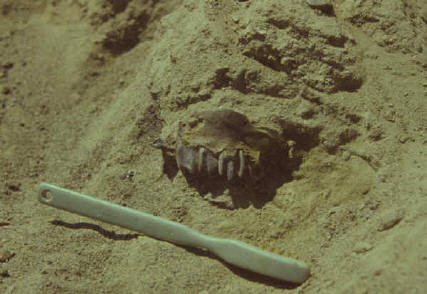|
Three Lower Jaws in One
On a Saturday three years later, the
boys, now organized as a fossil-hunting group, were again digging in fine sand
at Locality V3604 at a second site rich with Tetrameryx specimens.
Labeled T2, this site was about 1500 feet south of the original site, T1. (The
boys gave exceptionally rich pockets special identifications. Such information
would be useful to scientists should they wish to plot the exact places where
the fossils were discovered.)
 |
|
Camelops jaw T-2 |
One this Saturday much excitement was
created by a team member who was digging out the lower jaw of a horse. “Two
jaws, one on top of the other!” he called out. Under the horse jaws was the left
lower jaw of Tetrameryx irvingtonensis, with the six back (or grinding)
teeth intact. The boys wondered how the jaws of two such different plant-eaters
could have been buried together. Did the animals fall victim to a
band of wolves, or did a sabercat get one and wolves the other? Perhaps
they perished at a dried-up watering hole. This happens to animals in drought in
Africa and Australia.
The speculations continued: “What about
this idea?” asked one. “They may have died in a different place. Let’s suppose
that one of them died upstream and was buried during winter floods. Later a big
rain could have washed it down during winter floods. Later a big rain could have
washed it down here where it just happened to settle on top of the other.”
Another boy disagreed. “If that had
happened,” he commented, “the teeth would have been broken or eroded.”
Soon more complicated problems arose.
Under the two jaws was the left lower jaw of a camel. One boy was positive that
the cause of death must have been an extended drought. He visualized vultures
picking flesh from many carcasses and rains washing the bones into a deep pool.
“Don’t bring vultures into this,” one boy inside. “We haven’t found evidence of
vultures at Irvington.”
“But proof that they weren’t here hasn’t
been found, either,” stated another member of the group.
The director asked, “Couldn’t these
three herbivore have died of a sickness, such as the hoof-and-mouth disease?”
The group agreed that this was another possibility. With a smile, a boy
suggested that the animals were standing under an oak tree when a bolt of
lightning shattered the tree and killed them.
“Yes,” continued someone else, “a pack
of wolves came along and had their first meal of ‘cooked’ meat. The wolves
became so excited that they dragged the bodies of the camel, horse, and antelope
all over the place, until they happened to reach the big pool. There they
finished picking off the cooked meat and left the bones, Then came a big rain
that washed the bones into the water.”
What do you think? The following
information may help you to evaluate the suggestion that vultures picked the
bones of the three animals. Vultures are extremely common in the Irvington area
today. They were also common among the fossils discovered at Rancho la Brea.
Irvington and Rancho la Brea are about 400 miles apart and differ in Mammal Age
by more than a million years. Fossilized remains of ducks and geese have been
found at Irvington and in the tar pits. Were vultures at Irvington about 1.3
million years ago?
Whether or not you include vultures in
the ancient Irvington ecosystem depends on the rules you follow. If you decide
to include only the animals whose remains have been found and identified at
Irvington, vultures cannot be included. But you might decide to include animals
(and plants) that could or should have been present. This brings the discussion
to an extremely important consideration: Whatever your rules may be, state them
clearly so that your reconstruction can be judged fairly. You must, of course,
also make it perfectly clear that your reconstruction of past events merely
represents that could have happened not necessarily what did happen.
|